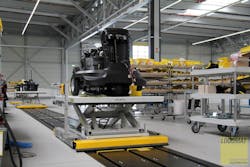If anything could be considered the universal symbol of manufacturing, it’s likely the conveyor line. From Henry Ford’s groundbreaking innovations to the unforgettable “I Love Lucy” episode where Lucy and Ethel hilariously fail to keep up with their chocolate-wrapping duties (yes, I’ve included the video below), the conveyor is likely more central to the modern concept of manufacturing than anything else.
Over the years, advances in conveyance tended to be more along the lines of specific device enhancements, such as motor, drive and controller improvements, or the movement from belts to rollers. But recently, I’ve encountered a number of new advances in conveyance technologies. In just the past year, I learned about Glide-Line’s new approach to conveyor design employing software-enabled custom designs and how battery-free automated guided vehicles (AGVs) are changing the way manufacturers approach the prospect of deploying AGVs.
Now I’ve been introduced to another option. The E-Cart system from LogoMat is designed to transport heavy and large products using electronically driven pallets designed for heavy-duty applications.
A key differentiator to the E-Cart conveyance approach lies in its design and operational approach. The self-driven electrical E- Carts get their 48V DC drive power and signal through integrated power rails in the system’s frame structure.
These power rails reportedly eliminate the need for motor starters, drives, and separate overload switches. Using these rails to power the E-Carts, the system requires no battery or pneumatic energy. Redundant power pick-ups are used to ensure transport of loads upwards to 2,000- 3,000 lbs.
A safety bumper is included in each E-Cart to prevent collisions with operators or anything else in the E-Cart’s way. Also, since the 48V DC drive power is harmless in direct contact situations, no additional protective devices are needed.
Each track consists of a steel structure with no moving parts, which means that forklifts and operators can drive and walk over the system without damaging it. But the system does not have to stay at floor level, it can be adjusted to regular working heights for different types of assembly operations.
Since there are no moving parts, LogoMat says there is no maintenance required on the track. All maintenance issues affect only the E-Cart itself, which can be replaced or exchanged when necessary.
The speed and direction in which the E-Carts move can also be adjusted to accommodate various assembly styles. Also, different segments in the track can provide different pallet speeds to create a dynamic drive capability, meaning that stop-and-go or continuous flow cycles can be selected as needed.
As promised, here's the classic "I Love Lucy" conveyor scene:

